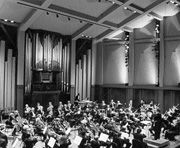AS MUCH FUN as the Seattle Symphony’s gala season-opener concerts can be, they’re definitely designed less to draw new orchestra fans than to celebrate current ones. The upscale, black-tie, champagne-at-intermission atmosphere at these galas is a large part of what alienates nonconcertgoers from classical music, earning orchestras a not-entirely-undeserved reputation of elitism. But the same weekend, the SSO was able to ameliorate the alienation of its opening gala with two events with a more populist—specifically, kid-friendly—bent.
Seattle Symphony
Benaroya Hall September 16, 17, 21
The first was the announcement of a $2.25 million grant from the Kreielsheimer Foundation, one of the last bequests before the Foundation closed its doors last week. Two million of the donation will go toward construction of the Learning Center, which will occupy the Second and Union corner of the Benaroya Hall complex. Scheduled to open this coming winter, the Center will include interactive musical exhibits and a performance/classroom space for programs such as the SSO’s Young Composers Workshop.
The remaining quarter-million is earmarked to help support “special artistic initiatives”—translation, the big, ambitious, offbeat choral/orchestral works that Gerard Schwarz champions. Works such as Hanson’s Merry Mount and Stravinsky’s Oedipus Rex have perhaps been tougher sells to tradition-minded audiences, but they’re a Schwarz specialty and they’ve provided some of the most thrilling high points of recent SSO seasons. The “Kreielsheimer piece” coming up this season in June is Janacek’s Glagolitic Mass.
The day after the gala, Sunday, was the third annual Day of Music, possibly the SSO’s single best idea. It featured seven hours of music and dance in four venues at Benaroya and at the Seattle Art Museum across the street, free to all comers. They’ve worked out the crowd-control bugs and getting from one venue to another this year was easy. This year’s theme was Pacific Rim arts, including gamelan, koto, and Andean music, along with apropos repertory choices from the traditional classical ensembles. The Northwest Mahler Festival Orchestra, for example, played Joseph Curiale’s Gates of Gold for Chinese er-hu and orchestra, in addition to reprises of Strauss’ Festival Prelude and the first movement of Mahler’s Symphony No. 8 from their impressive Meany Hall concert in July. Schwarz led the SSO in two Tchaikovsky pieces from the gala program (Romeo and Juliet was dazzling both times, with an involving heart-on-sleeve effusiveness I don’t usually associate with Schwarz performances), plus Hovhaness’ lovely Fantasy on Japanese Woodprints for marimba and orchestra.
THE HALL WAS FULL of kids, which meant that the Fantasy‘s pastel subtleties were largely lost, not only to the usual fidgeting and whispering but to a fair amount of outright screaming. Still, this was exactly what the Day of Music is intended to be, an informal introduction to concert-going. At every intrusive shriek, I just closed my eyes and muttered to myself, “They’re the audiences of the future . . . audiences of the future. . . .” More heartening was the enthusiasm shown for the musical instrument tryout areas, with volunteers lined up along the second-level promenade offering kids and adults the chance to scrape, blow, and bang on the instruments of their choice. It was a little overwhelming to think of the life-changing results a brief musical opportunity like this could have.
As it happened, I was joined by yet another youngster for last weekend’s subscription concerts, which showed off Benaroya Hall’s new Watjen Concert Organ in Saint-Sa뮳’ thunderous Symphony No. 3. Jessica is 8, and though she knows an enormous amount about gymnastics, movie musicals, and Friends, she’d never heard a live orchestra before. Except for the time one visited her school; the trumpeter stuck his mouthpiece in the end of a garden hose, put a funnel on the other end, and played the hose! That was pretty cool!
Anyway, I thought, what better introduction to symphonic music? This orchestra, in this hall, playing this piece? But even though Schwarz led a wonderfully tumultuous and sweeping performance, even though the orchestra (figuratively) and organist Carole Terry (literally) pulled out all the stops— Jessica dozed. She dozed through the finale, if you can believe it. Admittedly, it had been a long drive from Grandma’s in Vancouver; but it seems the Watjen still needs some beefing up before it’ll be ready to satisfy the most discriminating listeners.







